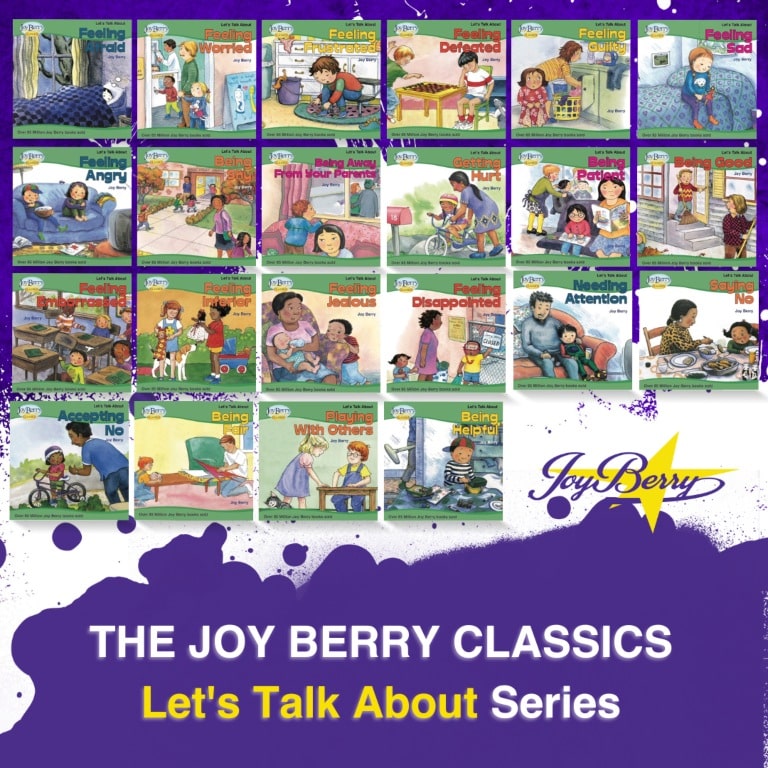The Official Joy Berry Website
Helping Kids Help Themselves
become responsible, happy, and successful
Menu
Menu
The Let’s Talk About Books For 3-5 Year Old’s
by Joy Berry
on October 21, 2023
While earning my Master’s Degree in Human Development, I learned that humans of all ages experience the same basic emotions. At the same time, emotional triggers normally vary from age to age. For example, while both children and adults experience anger, what prompts young children to become angry usually differs from what prompts adults to become angry.
Even so, the steps to handling emotions appropriately is the same for all ages—which is why I began efforts to teach very young children how to handle their emotions in ways that would help, rather than harm them. Creating the Let’s Talk About series of books was an important part of that effort.
Basic Premise For The Let's Talk About Books
Raw emotions, as well as emotionally charged situations are the source of a child’s first inner conflicts and discomfort. This inner turmoil can manifest in unacceptable behavior that can be troublesome to parents as well as children.
The Let’s Talk About books are based on the premise that emotions are neither good nor bad. Instead, it is how one handles an emotion that is good or bad. Therefore, rather than categorizing emotions as good or bad, the Let’s Talk About books categorize emotions as comfortable or uncomfortable. In addition, Let’s Talk About teaches that uncomfortable emotions can be positive as they often motivate a person to do something that needs to be done.
The purpose of the Let’s Talk About books is to educate young children regarding their emotions as well as the emotionally charged situations they encounter so that they can handle these emotions and situations in positive instead of negative ways.
Basic Layout And Contents Of The Let's Talk About Books
Each Let’s Talk About book features the following:
1. 32 pages
2. Each left page of a two-page spread contains approximately one to three simple sentences of text.
3. Each right page of a two-page spread contains a simple, full-page, color, cartoon illustration.
4. Each book contains a section dedicated to practical information for parents related to the subject of the book.
Developmental Organization Of The Let's Talk About Book
Children 3 – 6 years of age are naturally egocentric. Even their concern for other people is based on whatever personal benefits can be derived from others. Therefore, interest in personal emotions precedes a young child’s interest in interpersonal emotions, and interest in personal emotional situations precedes a young child’s interest in social emotional situations.
Given every child’s normal developmental progression from being egocentric to being social, from the concrete to the abstract, and from simple to complex, it is recommended that the Let’s Talk About subjects be presented in the following developmental sequence:
• Feeling Afraid
• Feeling Worried
• Feeling Frustrated
• Feeling Defeated
• Feeling Guilty
• Feeling Sad
• Feeling Lonely
• Feeling Angry
• Feeling Embarrassed
• Feeling Inferior
• Feeling Jealous
• Feeling Disappointed
• Feeling Cheated
• Feeling Rejected
• Being Away
• Being Shy
• New Situations
• Getting Hurt
• Getting Lost
• Being Afraid to Fail
• Being Patient
• Being Good
• Needing Attention
• Saying “No”
• Accepting “No”
• Being Cooperative
• Being Fair
• Playing with Others
• Being Helpful
• Making Others Angry
The Let's Talk About Books
The Let’s Talk About Feeling Afraid book defines fear and its causes and explains how to handle it in positive ways.
The Let’s Talk About Feeling Worried book defines anxiety and its causes and explains how to handle it in positive ways.
The Let’s Talk About Feeling Frustrated book defines frustration and its causes and explains how to handle it in positive ways.
The Let’s Talk About Feeling Defeated book defines defeat as well as its causes and explains how to handle it in positive ways.
The Let’s Talk About Feeling Guilty book defines guilt and its causes and explains how to handle it in positive ways.
The Let’s Talk About Feeling Sad book defines sadness and its causes and explains how to handle it in positive ways.
The Let’s Talk About Feeling Angry book defines anger and its causes and explains how to handle it in positive ways.
The Let’s Talk About Being Shy book defines shyness and explains how to replace it with positive social skills.
The Let’s Talk About Being Away From Your Parents book explains how to be okay during parent/child separations.
The Let’s Talk About Getting Hurt book explains how respecting the normal fear of getting hurt can prevent harm.
The Let’s Talk About Being Patient book explains the value of patience and encourages being patient.
The Let’s Talk About Being Good book explains what it means to be good and how to replace misbehavior with good behavior.
The Let’s Talk About Feeling Embarrassed book defines embarrassment and its causes and explains how to handle it in positive ways.
The Let’s Talk About Feeling Inferior book defines feeling inferior and its causes and explains how to handle it in positive ways.
The Let’s Talk About Feeling Jealous book defines jealousy and its causes and explains how to handle it in positive ways.
The Let’s Talk About Feeling Disappointed book defines disappointment and its causes and explains how to handle it in positive ways.
The Let’s Talk About Needing Attention book acknowledges the need for attention and explains how to get positive attention.
The Let’s Talk About Saying “No” book explains when it is appropriate to say “no” and how to say it in a kind yet effective way.
The Let’s Talk About Accepting “No” book explains when and why “no” is a valid answer and how to accept “no” graciously.
The Let’s Talk About Being Fair book defines fairness and its importance and encourages fair play.
The Let’s Talk About Playing with Others book teaches how to recruit playmates and how to treat them appropriately.
The Let’s Talk About Being Helpful book for 3-5-year-olds explains how being helpful can be positive for everyone and tells how to help others.
Guidelines For Using The Let's Talk About Books
In order to derive the maximum benefits from the LTA books it is recommended that adults use the books in the following ways:
Adult Resource: The adult reads the books for information, insights, and encouragement.
Adult-Child Activity: The adult uses the materials with the child and encourages the child to question or comment on the subject matter.
Independent Activity: The child is encouraged to use the materials independently of the adult for entertainment and to reinforce the subject matter.
Reference Material: The materials are placed in the child’s library along with other resource materials and used whenever specific situations need to be addressed.

Menu
Copyright © 2024 Joy Berry Enterprises. All Rights Reserved.




Leave a reply